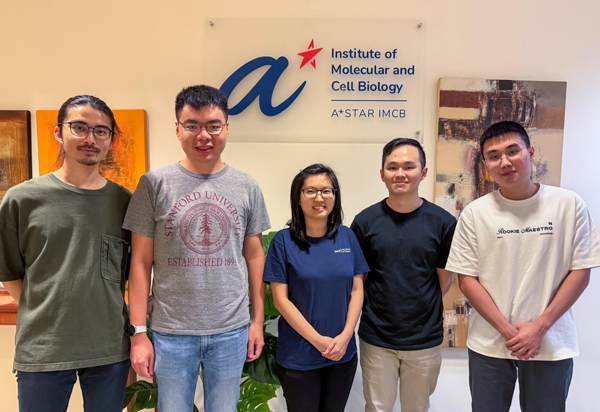
Dr. Jonathan Loh’s research team.
From left to right: Gary Wong, Zihao Zheng, Nadia Omega Cipta, Jackie Teo, Teo Jian Zhou
Unlocking Pluripotency: What Powers a Stem Cell’s Identity?What gives a stem cell its unique identity, the power to become any cell type, yet stay in a self-renewing state? A team of researchers led by Dr. Jonathan Loh at A*STAR’s Institute of Molecular and Cell Biology (IMCB) has found part of the answers in what was once considered “junk” DNA.
Published in Genome Biology, the study reveals how repetitive elements in our genome, specifically a type called MIRs, help shape the gene expression program of stem cells in their naïve state. These elements, also known as transposable elements, were traditionally seen as genetic fossils. But this research shows they act as powerful regulatory element.
The team compared two types of pluripotent stem cell states: the conventional naïve state, which mirrors early embryonic cells, and an expanded potential state, with the capacity to also form extraembryonic tissues.
Using a combination of genome architecture mapping (Hi-C), chromatin profiling (ChIP-seq), and enhancer interaction analysis (HiChIP), they discovered that MIR elements are highly active in the naïve state. These MIRs act as enhancers, or DNA regions that boost gene activity, forming looping structures that bring distant parts of the genome together.
One key player is ESRRB, a transcription factor that binds to MIR enhancers and helps maintain the stem cell’s naïve identity. The team found that removing a single ESRRB-bound MIR enhancer disrupted stem cell self-renewal, underscoring its importance.
ESRRB doesn’t work alone. It co-binds with YY1, a structural protein that helps organize the 3D shape of DNA inside the nucleus. Together, they form regulatory loops that keep naïve-specific genes switched on.
“Our exploration of transcription factors and repeat elements uncovers switches that guide stem cells between potency states, deepening our understanding and illuminating pathways for future therapies,” said Dr. Loh.
By revealing how repetitive DNA and genome structure coordinate to control cell fate, this work advances both stem cell science and regenerative medicine. It also repositions transposable elements, long dismissed as genomic clutter, as key players in developmental biology.


.png?sfvrsn=c3edc68e_6)